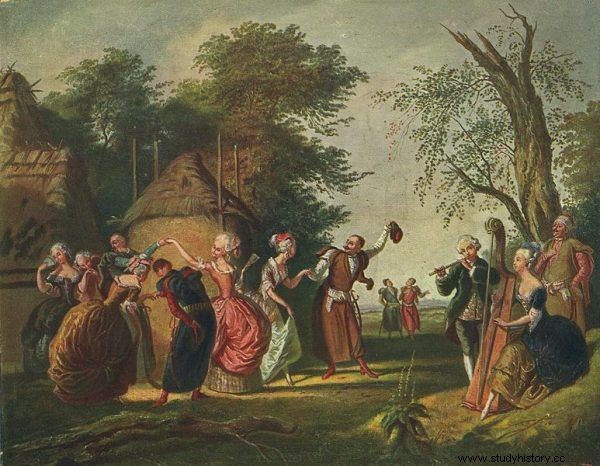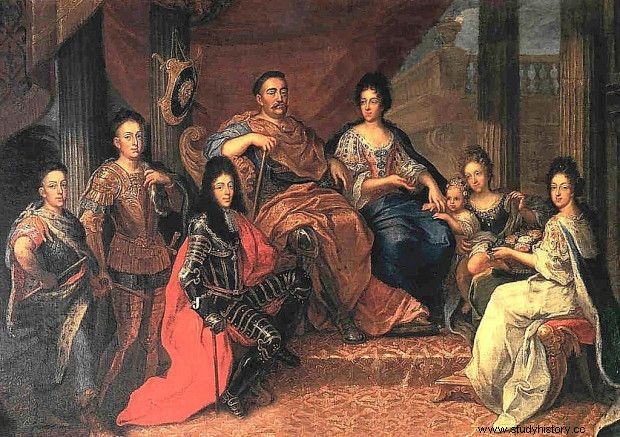On the one hand, shaved noble heads, Turkish robes, ignorance, drunkenness, exploitation of the peasantry, the fall of cities, on the other hand, patriotism, great battles and Polish identity. What is the Sarmatian myth really?
The term "Sarmatism" appeared in the 1860s, at the beginning of the Stanisław times. It was introduced for use by the authors and publicists of the Enlightenment, defining with it the Polish noble culture that developed at the turn of the 16th and 17th centuries. The descent of the ancient Sarmatian people was taken as true at the end of the 16th century. Sarmatism played an important political role because it motivated Poland's rights to a superpower, marking the eastern direction of the Jagiellonian policy, unifying the ethnic, linguistic and religious diversity of the Lithuanian and Crown societies.
"The Polish inscription of two parts of the world, which in Latin Sarmatia ..."
In the 17th century, Sarmatism changed. The term itself began to apply to the Polish, Ruthenian and Lithuanian noblemen, excluding other, lower social groups from this community. The nobility competed in creating the genealogy of their own families to such an extent that Załuscy, Opaliński, Lubomirscy or Radziwiłłów were to reach their ancestors from the Roman and even Greek times .

Polonaise in the open air
The system, rights and freedoms of the nobility, according to the Polish nobility, were institutions under special and extraordinary divine protection. The peak of megalomania was attributing to God the creation of the political system of the Republic of Poland. Conflicts arose, as the nobility was outraged by the fact that the reigning kings did not shy away from ties with the West, applauded foreign fashions and did their best not to raise the royal authority. The nobility demanded that foreign fashion and language be removed from the court, they wanted the king to wear a Polish robe and behave as befits a Polish nobleman. The Sarmatian nobility had a great dislike for Sigismund III Vasa, which the king was obviously well aware of.
Hostility towards other nations turned into xenophobia not only directed against the West, but also against Tatars, Gypsies and Jews. A true good Polish citizen was to be:virtuous, righteous, brave and pious, and an ideal Sarmatian is a great sejmik speaker, activist, man who protects the rights of the Homeland, a knight and a mediator. In addition, you can mention the favorite and most important feature of the nobility of the Sarmatian era - legendary freedom of the nobility . Each innovative proposal for a change at the Seym / sejmik was considered an attack on noble privileges and was treated with great distrust. Conservatism, the defense of noble and old Polish customs and the omnipresent traditionalism took root then. Thinking that the Sarmatians are owners of a perfect system resulted in consolidating the idea that in Poland nothing needs to be changed. As a matter of fact, such thinking became embedded in the consciousness of the entire nobility as a canon of political knowledge.
In the second half of the In the 17th century, wars with Sweden, Cossacks, Russia, Turks and Tatars swept through the country. These events made the chivalric spirit reborn. In 1674, the king was elected slayer of the Turks - Jan III Sobieski, who focused around his figure the features of a true Sarmatian and a good king.

Jan III Sobieski with his family
Weakening of the Republic of Poland
Superstitions and superstitions, based on fictional historical and geographical concepts, became common in life at that time, and instead of strengthening the country, they effectively weakened it. The conflict between the nobility and the middle class and peasants was deepening (as we know, these groups did not belong to the Sarmatian nation). The nobility took the election of Augustus II very badly because he was a supporter of an absolute monarchy following the French example. When the Swedish army invaded Poland during the Northern War at the beginning of the 18th century, it turned out that the country plunged into harlotry was unable to defend itself, and the nobility was rebuilding their estates instead of fighting. The nobility became selfish, vain, disorganized and primitive . The times that followed were not beautiful. A deep fall has come. The nobleman, apart from his yard, saw nothing more, and he probably did not even want to see it.
The times of reforms and attempts at changes must have come at last. Rent was carried out in large estates. The intellectual movement and political and social reform thought were awakened. No rush, but always growing interest in science and literature.
Sarmatism created a specific lifestyle, customs, fashion, politics and mentality. Although you can read a lot of bad words about this movement, it was undoubtedly one of the most original manifestations of Polish culture in the history of our nation.
Bibliography:
- Tadeusz Chrzanowski, Wędrówki po Sarmacji European, Kraków 1988
- Czarniecka Anna, Nobody listens to me in life ... Jan III Sobieski in the fight against the opposition propaganda (1684 - 1696).
- Dybaś B., Woldan A., Ziemlewska A., Sarmatian memory. Around the Battle of Vienna, Warsaw 2014.
- Works by Maciej of Miechów in the Polona.pl digital library
- Kowalski Piotr, Theatrum of the world of everything and a good host. On the vision of the world of a seventeenth-century landowner writer, Krakow 2000.
- Tazbir Janusz, The gentry culture in Poland, Warsaw 1983.
- Tazbir Janusz, Poland of the 17th century, Warsaw 1974.
